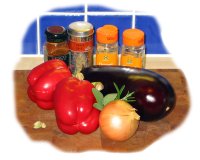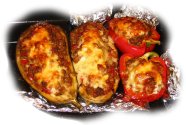Note: This entry has been restored from old archives.
Here’s a little something I cooked up on Monday (2006-07-23) night for dinner. It’s poached chicken served with rice and steamed veggies, the procedure made a good dinner for two with a pair of breasts left over for making lunch the next day. The prevalent flavours here are lime and coriander, I came up with this when wondering what to do with the large bunch of coriander I was left with after thinning out the pots on the balcony.
For a bit of organisation I’ve split the recipe up into four parts, the poached breasts, sauce, mayonnaise and rice; each stage uses outputs from earlier stages.
Poached Breasts
- 4 Medium Chicken Breasts
- 2 Limes
- 1 Brown Onion
- 1 Carrot
- 2 Cloves of Garlic
- Knob Of Ginger (ping-pong ball volume)
- Two Large Handfuls of Coriander (whole plant)
- Heaped tsp of Green Peppercorns
- 1 tsp of Chili Powder
- 2 Bay Leaves
- 1 tsp Ground Coriander Seed
- A Few Grinds of Pepper
- 1 Chicken Stock Cube
- Throw it all in a pot!
- More concise: Grate rind off both limes and juice, reserve 1 tbsp of juice and rind of one lemon for later, place the rest in a pot including the lime-halves (best size pot is one large enough for the four chicken breasts to sit comfortable side-by-side). Chop up the coriander and throw it in the pot, reserving about 3 tbsp of leaves for later. Roughly grate the ginger and place it and any other herbs and spices into the pot. Put the chicken into the pot and toss with all the flavourings. Roughly chop up the onion, carrot and garlic (crush it a bit) and throw it in the pot, skin and all!
- Fill the pot with water until it is about ½cm higher than the chicken. Bring to the boil and then turn to a low simmer. Simmer until the chicken is done, this typically means less than 15 minutes for medium sized chicken breasts. The typical test is to stab the breast in its fleshiest part, if the juices “run clear” then the chicken wont kill you. If the sizes of your breasts vary you may want to remove the more petite ones first. Some prefer to ensure that their chicken is dead, dead, dead; they simmer it for an hour – I don’t approve, this may be the way to go if you have tough old granny chicken breasts though.
- The poached breasts should be placed aside, snug in a smaller container with some of the poaching juice (about 150ml say). They’ll cool a little now, beware of this in warm weather though – you may want to place in a large freezer bag and put the lot into a bath of cold water.
- Remove the lime shells from the breast juice (squeezing out any liquid) and place back onto the stove and bring to a boil. Boil down to half volume then turn to a simmer and put the lid back on. Simmer until the carrot chunks are done like your granny does ’em – bleached of flavour and on the brink of mush.
Lime and Coriander Mayonnaise
- 1 tbsp of Lime Juice (left over from above)
- Grated Rind of 1 Lime (left over from above)
- 2 tbsp of Chopped Coriander Leaves (left over from above)
- 4 tbsp of Good Mayonnaise (make it yourself if you have the time!)
- Place half the lime rind and 1 tsp of the chopped coriander into a small
- container.
- Put the rest of the lime rind and coriander into a pestle and mortar with the lime juice and grind to a paste then place it also into the small container.
- Put the mayonnaise into the container and mix well.
Flavoured Rice
- 1 Cup of Basmati Rice
- 1 tbsp of chopped coriander (left over from above)
- Pour the liquid from the cooled chicken breasts into your rice cooker and make up the volume to that appropriate for the amount of rice you want to cook (typically 1.5 cups total liquid for 1 cup of basmati rice).
- Add the rice (washed if required) and turn on the cooker.
Simple!
The Sauce
- Take the reduced and simmered poaching liquid and push through a sieve into a bowl. Resulting liquid should be cloudy and slightly thickened. Place back into the pot, put on the stove and bring back to a simmer (at this point reduce further if you feel it is needed).
- Dissolve 1bsp of cornflour into water then stir into the simmering liquid.
- Continue to stir rapidly (with a whisk is best) until thickened.
- Season to taste and possibly passed through a strainer one final time (in case there are any lumps).
Beware of this sauce, I made the mistake of leaving the lime shells in for too long and it ended up quite bitter. I cut it by adding about half a cup of orange juice and a little honey – even then it was a bit too bitter to use in large amounts. Aside form the bitterness the flavour was excellent.
The Meal
- Dish out rice into two shallow bowls.
- Slice two chicken breasts into 1cm thick pieces and place onto a 1 tbsp dollop of the mayonnaise on the rice.
- Generously dollop with sauce (though I was more sparing with the sauce due to the bitterness mentioned above).
- Garnish with a crisscrossing of green mayo.
- I recommend serving with some steamed vegetables. I steamed the veges in a strainer in the top of the simmering poaching juice.


